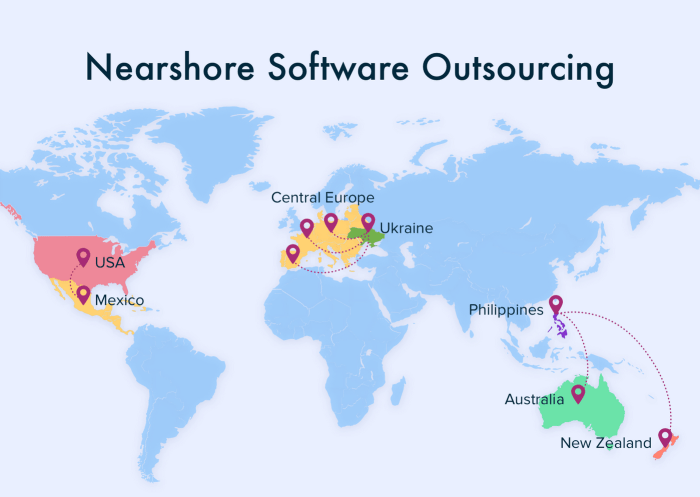In today’s rapidly evolving digital landscape, businesses are constantly seeking innovative ways to enhance their online presence and streamline their operations. Web applications have become indispensable tools for achieving these goals, but developing high-quality web apps requires significant expertise and resources. This is where nearshore software development emerges as a compelling solution, offering a blend of proximity, cost-effectiveness, and cultural understanding that can significantly benefit businesses of all sizes.
Understanding Nearshore Software Development
Nearshore software development refers to outsourcing software development projects to companies located in geographically proximate regions. Unlike offshore outsourcing, which involves engaging developers in distant countries (e.g., India, the Philippines), nearshore outsourcing focuses on countries within a relatively close time zone and often sharing similar cultural values and business practices. This proximity offers several key advantages, including improved communication, easier collaboration, and reduced time zone differences, ultimately contributing to a smoother and more efficient development process.
Nearshore software development offers a compelling alternative for web app projects, balancing cost-effectiveness with convenient communication. However, for larger-scale projects or specialized skills, exploring options like offshore software development teams can be beneficial. Ultimately, the best approach for nearshore development hinges on a project’s unique needs and resources.
Benefits of Choosing Nearshore Development for Web Apps
- Reduced Costs: While still offering significant cost savings compared to in-house development, nearshore development typically provides more affordable rates than onshore solutions, without sacrificing quality.
- Improved Communication and Collaboration: The reduced time zone difference and geographical proximity facilitate seamless communication and collaboration, leading to quicker project turnaround times and fewer misunderstandings.
- Enhanced Cultural Understanding: Nearshore partners often share similar cultural values and business practices, leading to better comprehension and alignment on project goals and expectations.
- Easier Travel and On-site Visits: The geographical proximity allows for easier and more cost-effective travel for meetings, project reviews, and other necessary collaborations.
- Access to Specialized Talent: Nearshore regions often possess a large pool of skilled software developers specializing in various technologies, including web application development, mobile app development, and cloud computing.
- Stronger Intellectual Property Protection: Working with a nearshore partner located in a country with robust intellectual property laws can provide greater security for your proprietary information.
- Faster Time to Market: Efficient communication and collaboration contribute to faster development cycles, enabling quicker product launches and a competitive edge in the market.
Choosing the Right Nearshore Partner for Your Web App
Selecting the appropriate nearshore development partner is critical for the success of your project. Here’s a checklist to guide your decision-making process:

Key Factors to Consider When Selecting a Nearshore Partner:
- Technical Expertise: Assess the partner’s experience and proficiency in relevant technologies (e.g., React, Angular, Node.js, Python, PHP) and their ability to handle the specific requirements of your web application.
- Portfolio and Case Studies: Review the partner’s portfolio to evaluate the quality of their previous work and their experience with similar projects. Look for case studies that showcase successful deployments and client testimonials.
- Communication and Collaboration: Evaluate their communication channels, responsiveness, and overall ability to work collaboratively. Consider scheduling a meeting or call to assess their communication style.
- Project Management Methodology: Inquire about their project management approach (e.g., Agile, Waterfall) and their ability to adhere to deadlines and budgets.
- Security and Data Protection: Ensure the partner adheres to strict security protocols and complies with relevant data protection regulations (e.g., GDPR, CCPA).
- Legal and Contractual Agreements: Carefully review all legal documents and contracts to ensure clarity on intellectual property rights, payment terms, and dispute resolution mechanisms.
- Cultural Compatibility: While nearshore partners often share cultural similarities, it’s still important to assess the level of cultural understanding and compatibility to ensure smooth collaboration.
- References and Testimonials: Request references from previous clients and contact them to gather feedback on their experience working with the nearshore partner.
Nearshore Locations for Web App Development
Several regions have emerged as popular nearshore destinations for software development. The optimal location will depend on your specific needs and priorities, such as cost, language proficiency, and time zone alignment.
Popular Nearshore Regions:
- Mexico: Offers a large pool of skilled developers, relatively low costs, and proximity to the United States.
- Central America (Costa Rica, Panama): Known for its strong English proficiency, skilled workforce, and stable political environment.
- South America (Colombia, Brazil): Growing tech hubs with a talent pool proficient in various technologies, although language barriers may require careful consideration.
- Canada: A premium nearshore option offering highly skilled developers and a similar time zone to the US, but at a higher cost.
Technologies Used in Nearshore Web App Development
Nearshore development teams are proficient in a wide range of technologies crucial for building robust and scalable web applications. These technologies span the entire development lifecycle, from front-end development to back-end infrastructure and database management.
Common Technologies:
- Front-end Frameworks: React, Angular, Vue.js
- Back-end Frameworks/Languages: Node.js, Python (Django, Flask), PHP (Laravel, Symfony), Ruby on Rails
- Databases: MySQL, PostgreSQL, MongoDB
- Cloud Platforms: AWS, Azure, Google Cloud
- DevOps Tools: Docker, Kubernetes, Jenkins
Frequently Asked Questions (FAQ)
- Q: What are the main differences between nearshore and offshore development?
A: Nearshore development involves outsourcing to companies in geographically closer regions, leading to better communication and collaboration compared to offshore development, which involves countries further away. - Q: How can I ensure the security of my intellectual property when using nearshore development?
A: Carefully review contracts, ensure the partner has robust security measures in place, and consider using NDA (Non-Disclosure Agreements) to protect sensitive information. - Q: What are the potential risks of nearshore development?
A: Potential risks include communication challenges (even with proximity), cultural differences, and finding a reliable partner. Thorough due diligence is crucial. - Q: How much does nearshore development cost?
A: Costs vary depending on the location, complexity of the project, and the experience level of the development team. It’s generally more affordable than onshore development but less expensive than offshore. - Q: How do I choose the best nearshore partner for my project?
A: Consider factors like technical expertise, portfolio, communication style, project management methodology, security practices, and contractual agreements. Conduct thorough research and request references.
Conclusion
Nearshore software development offers a compelling alternative for businesses seeking to develop high-quality web applications while optimizing costs and improving collaboration. By carefully considering the factors Artikeld in this guide and selecting a reputable nearshore partner, businesses can leverage the benefits of proximity, cultural understanding, and cost-effectiveness to achieve their development goals efficiently and effectively.
References
While specific URLs for articles on nearshore development are numerous and change frequently, a general search on Google Scholar, or reputable tech publications like Gartner or Forrester using s such as “nearshore software development,” “nearshore outsourcing,” and “web application development” will yield many relevant research papers and articles.

Call to Action
Ready to explore the benefits of nearshore software development for your next web application project? Contact us today for a free consultation and let us help you find the perfect nearshore partner to bring your vision to life!

